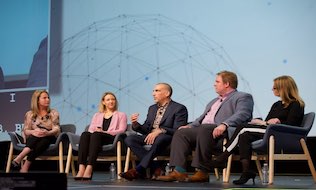

How do employers enable their workforces in the era of disruption?
Smart organizations are figuring this out by understanding what skill sets they’ll need in the future and preparing their employees through learning and development, said Tanya Blom, talent acquisition program manager at LinkedIn Corp., during a panel discussion at an event hosted by Microsoft in Toronto on Wednesday.
It’s an interesting and exciting, though potentially scary, time right now, she said. ”I was in New York last week, and I saw this giant sign that said, ‘Robots are taking your job.’ But it hit me because I hear this fear [or] perception a lot. We know there’s increased competition for talent, and there isn’t just a skills shortage but a skills gap with new technologies replacing, or relieving, us of some of the task-based repetitive work we’re doing. So the type of work we’re doing is changing.
Read: Microsoft to provide four weeks of leave under new caregiving benefit
“We’re moving away from traditional structures to matrix organizations,” added Blom. “People are working in teams cross-functionally on roles or project-based positions. And even mobility starts to look different.”
Employees also want to know the why, to understand a company’s mission and to be aligned with the its values, she noted. “They want to feel connected. And with work life, you ultimately want purpose. Employees crave progress. Successful companies with a strong mission, with strong purpose, are more successful, and it makes sense as to why this is, especially during rapid change and transformation. To have all the people connected in the journey is critical.”
Read: Majority of Canadian employers expecting HR disruption ahead: study
In the face of disruption, TD Bank Group focuses on its culture to support 85,000 employees. “In tough times, I think what you do is get back to basics, and we really approached it as a basics in two ways,” said Julie Branscombe, senior inclusion and diversity lead, talent and organizational effectiveness at the bank, during the panel.
First, the company considers what its employees want in their workplace culture. “They want to feel connected, they want meaningful work, they want to feel purpose-driven, have psychological safety and trust in the environment,” she said. ”They want to work with leaders, role models. And so we’ve invested in our leaders to say, ‘How are you creating that space for people in tough times?’ And that’s been working.”
One critical point, according to Branscombe, is that hiring diverse candidates who think outside the box will help drive innovation. “Those are the people that are going to get us to the other side. They’re going to actually help us transform, to help us see where we need to go and drive the big picture.”
Read: Public Policy Forum partners with TD Bank to explore the future of work
